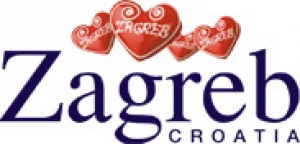Zagreb - the city with a heart

The fact that the Zagreb archdiocese was founded in 1094 and that the city was proclaimed a free royal city in 1242, attests to its long history. Zagreb was founded in a place where the last hills of the Alps merge towards the edge of the Panonian valley, making it an ideal spot for building a city within the Medvednica mountain hills (the highest point is Sljeme at 1,035 meters, a favorite picnic spot for Zagrebians) and along the Sava River valley.
Zagreb is the administrative, economic, diplomatic, and cultural capital of the country, with a population of almost one million. It is also a university center with forty higher education schools and over 40,000 students, it is a city that is proud of its long history of education: the first secular city school was built in the middle of the 14th century, the first secondary school was founded at the beginning of the 16th century, and in the second half of the 16th century, Zagreb had its first university.
Zagreb is a city of science and culture. Many excellent scientists and artists, who have enriched Croatian and world heritage, work here. The city has approximately fifty museums and galleries, as well as private art collections and about twenty theatres and musical venues. In 1895, the city’s oldest theatre, the Croatian National Theatre, with its neo-baroque architecture, was opened by the Austro-Hungarian emperor Franz Joseph I.
Many open air events and exhibitions are organized from spring to autumn. They create a very special atmosphere in the city and are a true tourist attraction.
Other main attractions include one of Europe’s most lively outdoor markets, and visiting it always proves to be a memorable experience to all visitors to Zagreb. It is here that you will remember those almost forgotten scents and tastes of childhood and where you will enjoy a diversity of color.
Despite being a Central European city in geography, culture, and baroque architecture, in many ways, Zagreb has a Mediterranean way of life. Thanks to its many influences, the city has a special charm and hospitable feel generated by its open-hearted people. Many say that nothing compares to this city!
ADVERTISEMENT
A walk through Zagreb is an interesting and pleasant journey that encapsulates both history and modern day life. Ilica, the longest street in Zagreb, divides the city into the old romantic Upper Town and the young, busy, and business-oriented Lower Town. The oldest areas, Gradec and Kaptol, from which Zagreb arose, are considered to be one of the most preserved and beautiful European city centers built in the Art Nouveau style. The Upper and Lower Towns are connected through the Kamenita vrata (Stone gate), yet another recognizable Zagreb tourist attraction that is linked to many legends and beliefs, as well as to faith and peace.
For some, the most recognizable place in Zagreb is its neo-gothic Cathedral situated at Kaptol. Although it took many centuries to build, the Cathedral that stands today was completed at the end of the 19th century. The Cathedral’s treasury has kept priceless treasures and objects that date back from the 11th to 19th century. The people of Zagreb are especially proud that during his first visit to the city, Pope John Paul II held a special mass inside the Zagreb Cathedral, commemorating 900 years since the founding of the Zagreb archdiocese.
Others tend to remember the always lively central Ban Jelačić Square or The Mimara Museum, also known as the Zagreb Louvre. Among the city’s many monuments is the oldest Zagreb cemetery called Mirogoj, which was opened in 1876. Thanks to its monumental neo-renaissance arcades, tombs of many famous Croatians from political and cultural life lay there. Numerous grave stones have been built by famous artists. Mirogoj is a must-see place for visitors to the city. Zagreb is also the site of many cultural and international events.
A city which has so many young people is bound to be very sporty, with many sports facilities, it also pays homage to an abundance of European and world sports champions, many of whom have won medals at prestigious sporting events.
The journey through Zagreb is not finished. You may best learn about it by walking down the city streets and enjoying a cappuccino in one of its many city cafes. The biggest value of this city is its atmosphere and the people who never allow you to feel alone. Zagreb has a story to tell and it has a heart, a big heart.
City.Mobi
Also in Croatia today, City.Mobi is celebrating the success of its new guide to Zagreb.
City.Mobi offers the most comprehensive mobile travel guides available, with over 800 cities in 200 countries listed. Each is developed by the City.Mobi team to combine into a single global travel directory.
However, each city retains its own mobile identity via a dedicated domain. Already on offer are Brussels.Mobi, Paris.Mobi, Sanfrancisco.Mobi and Sydney.Mobi.
Zagreb.mobi is the latest in this illustrious line up, offering click to call functionality – which means no scribbling down telephone numbers.
Most entries are also linked to websites where users can quickly access more detailed information if needed.
Other key features include information on accommodation, restaurants, attractions, entertainment, nightlife, shopping, and transport.
City.Mobi guides include user reviews and traveller utilities such as a translation guide, currency converter, news and local weather guide.

